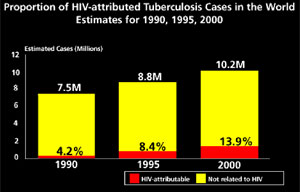Research Projects: Mycobacterium tuberculosis
Overview | Project page

About Tuberculosis
TB movie: http://www.stoptb.org/events/partners_forum/2004/assets/flash/default.html
Infection and transmission
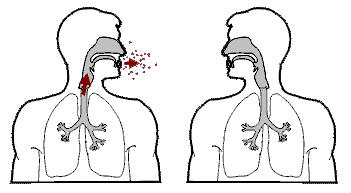
(Animation taken from: http://www.fw-ac-deptofhealth.com/images/tbanim2.gif)
Tuberculosis (TB) is primarily an airborne disease. The disease is spread from person to person in tiny microscopic droplets when a person with untreated pulmonary TB disease coughs or sneezes.
The process of catching tuberculosis involves two stages: first, a person must become infected; second, the infection must progress to disease.
To become infected, a person has to come in close contact with another person having active tuberculosis. In other words, the person has to breathe the same air in which the person with active disease coughs or sneezes. However, prolonged exposure to a person with untreated TB usually is necessary for infection to occur.
Mycobacterium tuberculosis
Mycobacterium tuberculosis is a well-equipped intracellular pathogen as evidenced by its natural ability to adapt and reside within the human macrophage phagosome and to persist within the human host for many years.
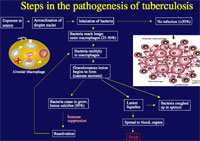 (click here for enlarged view)
(click here for enlarged view)
In most individuals, disease progression does not occur and the initial infection produces a compact, self-limited granulomatous lesion which is an effective means of containing the spread of the bacteria. Reactivation of a persistent infection occurs during immune senescence, immunosuppressive therapy, or conditions that allow the tubercle bacilli to escape immunological control and reestablish active disease.
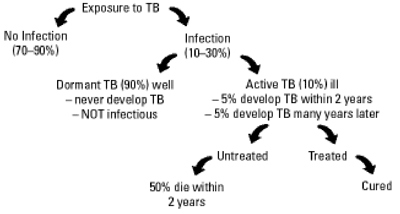
Global and regional incidence
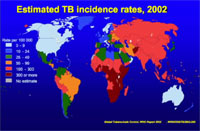 (click here for enlarged view)
(click here for enlarged view)
Tuberculosis remains a significant world health burden with approximately one-third of the world’s population estimated to be infected and a mortality rate of 2 million people per year.
 (click here for enlarged view)
(click here for enlarged view)
Additionally, due to the rapid progression of both tuberculosis and HIV in coinfected individuals, tuberculosis is the leading cause of death in HIV-infected individuals and is the causative agent in 13% of AIDS deaths worldwide.
